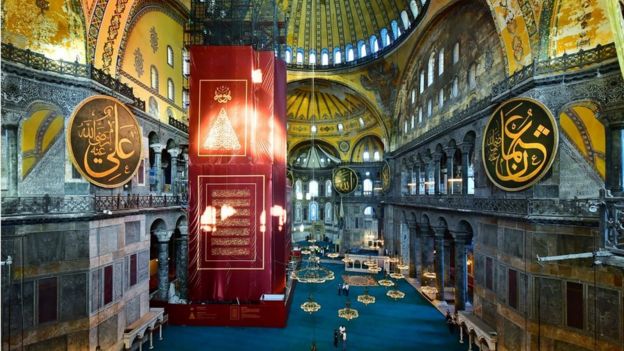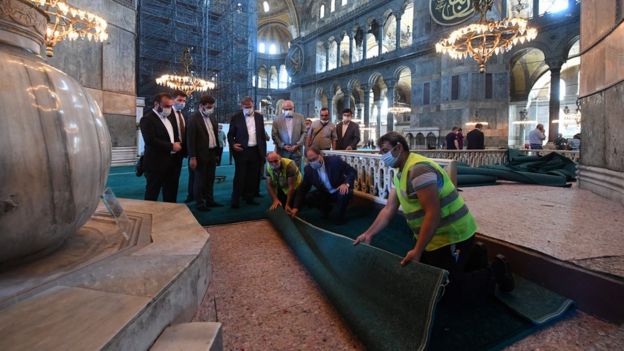I was looking into some news websites and i saw these few articles about the expansion in the Muslim Holy Cities of Mecca and Medina.I also saw a few artworks regarding the layout of the two Mosques of yesteryear as well as photographs of Mecca and the Kaabah during the early years of photography. While reading and examining them I thought I might do a little research on this topic, a little study on the development of the two cities, as well as Islamic cultural and artistic impact these recent growth caused.
A Brief History of Mecca, The First Holy City of Islam

An Imagining of the development of Mecca from the early years to recent
Mecca, or more closely to the Arabic pronounciation, Makkah, and also known as Bakkah, is a city in the Hejaz region (The Arabian Peninsula) some eight kilommetres inland from the Red Sea, in the west. Historically, the place has always been a sacred place – A Greek Historian, Dodorus Siculus, noted that ‘a temple and been set up there, which is very holy and exceedingly revered by all Arabians’. According to Islamic traditions, Ibrahim and his son Ismail (Abraham and Ishmael) built the structure which is now known as the Kaabah, where is it also said that the first man, Adam, built the same structure in the same place.
During the times of the Prophet Muhammad, Around 5th and 6th Centuries AD, Mecca was the temple for Arabian pagan tribes’ deities. It is said that there were more than 350 images or statues in that area alone, presumably one for each day of the year.
Prophet Muhammad was born in Mecca in 570, went to live his life as one of the Hashimite (Hashimiyah) of the Quraisy Tribe, until he began recieving Divine Revelations from God brought down by the Angel Jibril (Gabriel) in 610. From there he and his companions and followers were in constant struggle with the pagan tribes until Muhammad were commanded to leave Mecca for Yathrib (later known as Medina) after 13 years of enduring persecution, in 622.
While Muhammad were based in Medina, the Meccan pagan tribes keep harrassing the Muslims with wars, although their efforts are in vain and unable to defeat Muhammad and his followers.
In 628, Muhammad re-entered Mecca and rededicated the Kaabah and the city to the the worship of Allah. Mecca since then became the Islamic pilgrimage site, and the most holiest city in the Islamic World.
After the Prophet Muhammad’s death in 632, Islam expanded rapidly under the rule of his successors. However, Mecca were never made the capital of each of the Islamic empire or Caliphs, although it was always given special attention in terms of development of the city and its infrastructure.

An image of the Kaaba and the Meccan Surroundings in 1850s
The Ottoman ruled over the Holy City since 1517, and various improvements were made such as the building of the Great Mosque around the Kaaba, as well as general improvisation to the Kaaba itself. However the sovereignity over the city changed hands several times, particularly during the modern era. in 1803 the city was caputed by the first Saudi State and held it until 1813. It was in that year the Ottoman reclaimed the city and held it until the First World War, where it was seized by Syed Hussain bin Ali, the Shariff of Mecca as an Ottoman Governor. He revolted again the Ottomans, and suceeded in claiming the city in 1916 and announcing it as the Capital City of his new Kingdom, the Kingdom of Hejaz.
in 1924, during the Battle of Mecca, the Sharif were overthrown by the Saud Family and the city incorporated into the new Saudi Arabia.It was since then, rapid changes and development were made and done up to this day.
The Short History of the Prophet’s City

Medina in the 1940s. You can see the Prophet’s Mosque in the distance with the Green Dome.
Medina, or in Arabic Madinatun Nabawi (The Prophets City), or Madinatul Munawarah (The Enlightened City) or formerly known as Yathrib, is a city around 340km North of Mecca.
Medina became historically relevant to Islam ever since Prophet Muhammad made his Hijra from Mecca to Medina in 622. Medina became the site of the first mosque for the Muslims, called the Quba Mosque.
Medina also became the site of another important site of Islam – the Qiblatain Mosque. The name came from the duality form of the word Qiblat. This is the mosque where the direction of prayer (Qiblat) were changed from Jerusalem in Palestine to Mecca.
There were a number of battles significant to the rise of Islam ever since the Hijra of the Prophet. The greatest ones were the Battle of Uhud, the Battle of Badr and the Battle of the Trench, battles that were fought to withhold Islam’s sovereignity and to safeguard the Muslims’ Survival.
The Prophet were buried here in the Masjid An-Nabawi (the Prophet’s Mosque) and his companions Abu Bakar and Umar were laid to rest next to him. The tomb sites was actually the site of one of the prophet’s wife, Aisyah’s home. The site itself were adjecent to the prophet’s home.

A View of Medina with the Prophet’s Mosque
As with Mecca, Medina were under the rule of the different caliphates and kingdoms that succeeded the Prophet Muhammad. Among the significant rulers were the Rashidien Caliphate, the Egyptian Mamluks
during the 13th Century, the Turkish Ottoman in 1517 and the Saudis, after the First World War, which, again similar to what happened in Mecca, Medina was subject to rapid growth and development.
The Impact of the Developments
I was rather disheartened when I learned what happened to these two Holy Cities of Islam under the rule of the Saudi Arabia. As I have noted before, both Mecca and Medina were subject of special attention from the different Caliphates and Kingdoms of which the cities were ruled under. Most noticably are the improvements made by the Caliphates ; Mamluks, Ottomans – structures were build such as gates and fortifications around these two cities, as well as improvisations on the holy sites around the Kaaba and the Prophet’s Mosques such as general building of the Grand Mosque in Mecca.
However, under the Wahhabi Saudi, unfortunately and deeply saddening, we can never be able to admire and visit the sites. As much as 95% of the original structures in and around the cities were destroyed, including those which were built during the Mamluk and Ottoman Caliphate, and even those that were dated during the Prophet’s time! Graves were flattened, mausoleums were destructed and even mosques were demolished to make way for modern amenities for the approximately 4 million Hajj pilgrims who came to these sites every year.
In Mecca, the surroundings of the Grand Mosque of Mecca were completely flattened to make way for modern multinational, multi star hotel, shopping arcades retail an fast food chains and this gargantuan clock tower that overshadows the mosque and Kaaba itself. It is also said that one of the structures demolished was the home of the Prophet’s first and beloved wife Khadijah, to make way for a public toilet. The house in where the Prophet were born is now a public library although plans were made to demolish it.
In Medina, the same thing happened – the whole old city were razed to make way for modernity, losing the city cultural and historical heritage sites. It is said that many historical sites that were very significant in Islam such as the Salman Al-Farsi Mosque, the Jannatul Baqi cemetary and even the Prophet’s house himself were not spared under the bulldozers.There were apparently even plans of flattening the Prophet’s tomb!
Islam had lost many, many historical, cultural and artistic heritages around these two Holy Cities, and I hope that the rampant development, while it may bring comfort for the Hajj Pilgrims, will cease someday soon so that we may be able to study and be proud of our heritages.

People eating on a rock next to the Hilton Hotel in Mecca. Hilton Hotel. In Mecca. Unbelievable


























 The Dome of the Rock, with its golden dome in the vicinity.
The Dome of the Rock, with its golden dome in the vicinity. The Hagia Sophia, once a church, a mosque and now a museum.
The Hagia Sophia, once a church, a mosque and now a museum.  The Church of the Holy Sepulchre, the front facade.
The Church of the Holy Sepulchre, the front facade.










